
Related
The Missouri town of Ferguson looks like a war zone as police fire tear gas, stun grenades and smoke bombs to break up a fifth night of protests over the police shooting of unarmed African-American teenager Michael Brown. At least 10 people were arrested on Wednesday, including St. Louis Alderman Antonio French, who has been posting video online of the protests and who appeared on Democracy Now! earlier this week. An earlier protest faced a heavy police response, with police in riot gear stationed by a massive armed vehicle in the street. Journalists from The Washington Post and Huffington Post were also arrested last night and then released without charges. They were detained while filing reports from a McDonald’s restaurant. Ferguson police have refused to release the name of the officer who shot Brown, citing fears for his safety. They have also called on demonstrators to limit their protests to daytime hours. We go to St. Louis to speak with Patricia Bynes, Democratic committeewoman of Ferguson Township. Bynes has been out in the streets of Ferguson every night documenting the protests on Twitter.
Transcript
JUAN GONZÁLEZ: We go now to Ferguson, Missouri. [footage from Ferguson, Missouri] That was the scene in Ferguson, Missouri, just outside of St. Louis last night, as police fired tear gas, stun grenades and smoke bombs to break up a fifth day of protests following the fatal police shooting of Michael Brown. The unarmed African-American 18-year-old was shot dead on Saturday. Police say Brown assaulted an officer and tried to reach for his weapon, but eyewitnesses say Brown was shot with his arms up as he tried to flee an officer’s fire. Local police have still not released the name of the officer who shot him.
Earlier this week, police said an autopsy confirmed Brown died of multiple gunshot wounds, but they refused to say how many times he was shot or to release any more details, pending toxicology results, which could take weeks. An attorney for Brown’s family said the teen’s body has been turned over to them, and they plan to seek a second autopsy. On Wednesday, officials confirmed the Justice Department had opened a federal civil rights investigation into the shooting.
Last night police arrested at least 10 people, including St. Louis Alderman Antonio French, who has been posting video online of the protests and who appeared on Democracy Now! earlier this week. Journalists from The Washington Post and The Huffington Post were also arrested last night and then released without charges. They were arrested while working on stories at a McDonald’s restaurant.
AMY GOODMAN: At times the streets of Ferguson, Missouri, looked like a war zone this week, as police patrol the streets in armored vehicles. News photographers captured a striking image earlier this week of a team of police officers dressed in military gear pointing their high-powered guns at a young African-American man who has his hands in the air. Yahoo News reports the Defense Logistics Agency has confirmed the Ferguson Police Department is part of a federal program in which the Pentagon distributes hundreds of millions of dollars of surplus military equipment from the wars in Iraq and Afghanistan to civilian police forces across the country.
For the latest on Ferguson, we go now to St. Louis, where we’re joined by Patricia Bynes, Democratic committeewoman of Ferguson Township. She’s been out in the streets every night documenting the protests on Twitter.
Patricia Bynes, thank you so much for joining us. Can you describe what took place last night?
PATRICIA BYNES: Hi, Amy. Good morning.
Last night, it started—well, first, tensions are continuing to rise. It’s been a very volatile situation going on in the community. There had been tear gas prior to the two nights before. And even—what was it—Tuesday night, there was another officer-involved shooting that happened. So things continue to escalate. There were peaceful protests during the day. I know that there was a call to ask people not to demonstrate at night. And I just don’t see how that is not going to happen. The protesters and residents who support this cause are not going to be forced to stay in their houses when they want to show just how unjust this really, really is.
Last night, it got very chaotic very quickly. This was the most, I guess, visceral response that I’ve seen by the police so far. They had the armored cars out, you know, a lot sooner than I expected. You had police in military uniform sitting on top of the trucks with, you know, snipery-looking rifles pointed at people—in the daylight. People were out protesting in the day. Even a church group had come down on a flatbed truck and was playing gospel music, and they still had this type of artillery-looking equipment out on the street. It was pretty scary even in the daylight. And as it started to get dark, things got a lot more out of control.
JUAN GONZÁLEZ: And Patricia—
PATRICIA BYNES: Tear gas—I’m sorry.
JUAN GONZÁLEZ: Patricia Bynes, what about this whole issue of the police chief refusing to release the name of the officer or even any details about how many times Michael Brown was shot? What’s been the impact of that reticence to provide basic information in the community?
PATRICIA BYNES: Well, this just adds to the level of mistrust that people have been saying and discussing for quite some time. People in the community know who the officer is, because he shot Mike Brown in broad daylight in the morning. And so, for the people in the community, they know the police officer. We think it’s right to release his name. That way, there can be other people—
AMY GOODMAN: Can you tell us his name?
PATRICIA BYNES: I’m not going to do that. But we know that there are people in the—
AMY GOODMAN: Go ahead with what you were saying.
PATRICIA BYNES: We know that there are people in the community who may have been harassed by this officer, and if we make his name known, they might have a chance to come forward and tell other things that he may done to other people. But this is the type of thing—it’s aggravating the community, and it’s really, really making things worse.
AMY GOODMAN: I wanted to turn to the reporters who were arrested at McDonald’s.
PATRICIA BYNES: Yeah.
AMY GOODMAN: Washington Post reporter Wesley Lowery and Huffington Post reporter Ryan Reilly were both arrested Wednesday after police in SWAT gear entered a McDonald’s, where they were working, and ordered everyone to leave. Reilly said the police asked him for an ID after he started taking photos. He spoke to MSNBC’s Chris Hayes.
RYAN REILLY: And the worst part was he slammed my head against the glass purposely on the way out of the McDonald’s and then sarcastically apologized for it. They essentially acted as a military force. It was just incredible.
AMY GOODMAN: That’s Huffington Post reporter Ryan Reilly, who was arrested along with Washington Post reporter Wesley Lowery. Lowery said the police, quote, “slammed me into a soda machine, at one point setting off the Coke dispenser.” Later on, Los Angeles Times reporter Matt Pearce tweeted, quote, “Ferguson chief tells me @WesleyLowery and @ryanjreilly’s arresters were 'probably somebody who didn't know better.’” And then I heard a debate this morning, Patricia Bynes, on CNN, where the person defending the police officers was saying, “You don’t know. Don’t rush to judgment. They might have arrested the reporters to protect them.” Patricia Bynes?
PATRICIA BYNES: Oh, wow. That’s the type of protection we need these days? It’s adding fuel to the fire of a community that already does not trust them. So now we’re seeing escalated cases of asking media to stop filming. There was a tear gas thrown at a Al Jazeera crew last night, and police came and took down their cameras. So, if they’re concerned about looking thorough, it’s just not looking fair. And so, when the community is calling for a fair and thorough investigation, and St. Louis County thinks that they can do that, this type of quasi-military activity and trying to come down hard on the media doesn’t help that.
JUAN GONZÁLEZ: Could you talk somewhat about the town of Ferguson and the history of the development of racial tensions with the police force, a now overwhelmingly majority black community, yet the police force is almost totally white? Could you—
PATRICIA BYNES: Right, right. So, we have a history of certain municipalities in the St. Louis County that the majority of the population that live there are black, but due to socioeconomic reasons, they don’t participate in the political process. And it tends to be a little bit more complicated in St. Louis County, because you have a level of municipal government, then you have a level of county government, you have a different political body for school boards, in certain areas you have a different political body for fire boards. And so people who are worried about, “Can I get a job? Can I get to work? Can I put food on the table?” when Election Day rolls around, they don’t really think about that. They hardly participate at the level of presidential elections; we know that that might be what they vote for. So, the people in the community who tend to be in a much better socioeconomic status, who also might tend to be white in those committees, they vote. And unfortunately, the school boards and the municipal, aldermatic or the council boards or the mayors sometimes look nothing like the community that’s actually there, but they look like the people who continue to vote. And it gets frustrating, because they pass laws that are actually working against the majority of the population there and only help protect a small few. It’s sad, and it’s frustrating. It’s been going on for quite some time, and it just seems like this has just been bubbling up for a long time.
AMY GOODMAN: And, Patricia Bynes, this issue of the Ferguson Police Department being part of this federal program in which the Pentagon distributes hundreds of millions of dollars’ worth of surplus military equipment from the wars in Iraq and Afghanistan? I mean, it’s interesting because it certainly looked like that yesterday. Were there MRAPs in the streets?
PATRICIA BYNES: I don’t know what an MRAP is, but I know that we did—
AMY GOODMAN: The military vehicles.
PATRICIA BYNES: I’ve just been seeing them say “St. Louis County SWAT” on it. That’s what I’ve seen. I haven’t seen necessarily tanks. I have not seen that. But they have been in the military garb. What usually has been tending to happen at the protest level, first police during the daytime are out in their regular plainclothes police; as things escalate, they might start putting on the riot gear with the clear shields and the masks, holding the billy clubs; and then, as the night proceeds, there seems to be a change, a shift in change, and then you’ll see the more military—the trucks come out, as the sun starts going down.
JUAN GONZÁLEZ: And what’s been the impact of some national African-American leaders, like the Reverend Al Sharpton, who’s been out there this week trying to urge calm and also to make ties between what’s happened there in Ferguson and the death of Eric Garner here in Staten Island also at police hands, another unarmed African-American man? Has this helped the situation there or made it worse?
PATRICIA BYNES: I think, for a certain part of the community, it certainly has made—it’s made it better. I actually went to a very brief portion of the meeting that Reverend Al Sharpton was supposed to be at. It was a very nice gathering. People were singing church songs, I mean, feeling good, because many people in the community need that feel-good sense of this is going to be OK, we’re going to pray our way through this. But as I sat in church and I started looking at my Twitter feed, I saw that things were escalating out on the streets. So, that evening, I left the church and went down to the QuikTrip, which has become the symbol of this movement, and that’s where I decided to stay. But after that large peaceful event that Reverend Al Sharpton hosted, they even sent people down to bring them from the QuikTrip to come to this rally in the church. And they had a peaceful walk down to the QuikTrip afterwards. So, in certain aspects, it’s making things better. But I think that there are things that are going on, like they won’t release the autopsy reports for the young man and then the other officer-involved shooting the night before—those are things that are adding to a very volatile situation here in St. Louis County.
AMY GOODMAN: Well, Patricia Bynes, of course, we’ll continue to cover this. The group Anonymous has released a name of a police officer, but we cannot confirm this. Patricia Bynes is Democratic committeewoman of Ferguson Township, joining us from St. Louis. Before we go to break, I want to share a remarkable photo taken on Wednesday by students at Howard University, the historically black college in Washington, D.C. The photo shows hundreds of students with their hands in the air. Students posted it online with the hashtag #DontShoot.
This is Democracy Now!, democracynow.org, The War and Peace Report. It’s the first anniversary of a massacre in Egypt. We’ll go to Cairo, and we’ll speak with people here in studio. What does this all mean? Stay with us.

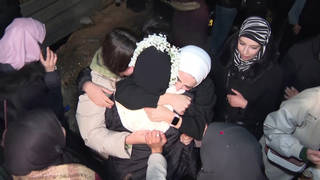
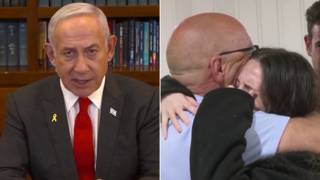
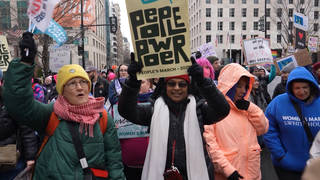
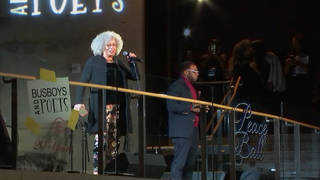
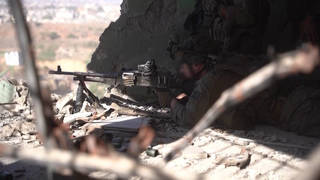





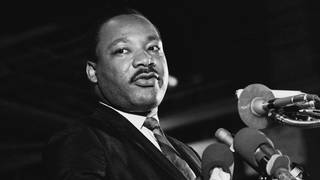
Media Options